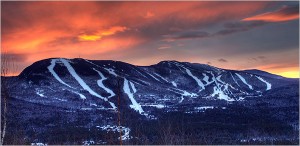
Over break, I travelled to Maine with a couple friends (including a fellow lodger: Natalie) for a little less than a week. Even though the ski condo that we stayed at was located in the mountains about an hour and a half outside of Portland, it seemed as if we could have been anywhere in the northeast (apart from the surrounding mountains). I’m sure if I had spent more time there, however, I would have been able to discern some of the more subtle differences between the landscapes of different states, but to my untrained eye, it all looked pretty similar to what I have seen before in the northeast United States.
I will, however, make one exception to my above statement. One difference between the landscapes of southern Maine and those of others I have seen up north is the abundance of birch trees that line up along the multitude of lakes and rivers that were scattered around the region. I could not tell at the time if the trees were the same types of river birch that are so common around Richmond, but I looked up some information on Maine ecology when I got back to campus and discovered that they were likely Gray Birches, White Birches or Paper Birches.
One of the other aspects of the local landscape that struck me from my trip was the presence of stark, vertical strips of white on the mountains that marked the paths of ski trails. Given what I know now about watersheds and the importance of trees as buffers for runoff, I can’t help but think that the lack of trees on an entire section of a mountain would have a big impact on the local watershed. Perhaps the lack of a filtration system or trees to slow down the speed of water traveling down the mountain would not be as big of a deal if the area were untouched by humans, but the ski resort and the pollutants it produces certainly have a negative impact.
Despite the presence of the ski community, Maine’s watersheds seem cleaner than those around here, and those around my home in Pennsylvania, mostly because the area is very lowly populated and all of the streams and lakes I saw had decent (but not necessarily great) riparian buffers. Trees and other smaller plants were certainly present around the edges of the water, but many sections were sparse and therefore probably not very successful at protecting the water adjacent to them. Overall, I might not have been able to notice too many differences between the landscape of Maine and the landscapes of other northern states, but it was nonetheless great to get outdoors again and away from the bustle of society.
